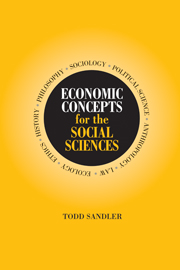Book contents
- Frontmatter
- Contents
- Table and Figures
- Preface
- 1 Economics without Apology
- 2 Back to the Future: Political Economy
- 3 In Another's Shoes: Games, Strategies, and Economics
- 4 It Takes Two or More: Public Economics and Collective Action
- 5 Government for the Politician? Public and Social Choice
- 6 Institutions Matter: The New Institutional Economics
- 7 Knowledge Is Power: Asymmetric Information
- 8 Everything Ties Together: General Equilibrium
- 9 Laboratory Economics: Of Rats and Men
- 10 Before Yesterday and Beyond Tomorrow: Intergenerational Economics
- 11 Fish, Space, and Spaceship Earth: Bioeconomics and Interdisciplinary Economics
- 12 Crystal Ball Economics: Rational Expectations
- 13 How Do We Get There from Here? Transition Economies and Policy Reforms
- 14 Economic Growth: Endogeneity, Institutions, and Other Concepts
- 15 Economic Visions of Future Horizons
- References
- Author Index
- Subject Index
8 - Everything Ties Together: General Equilibrium
Published online by Cambridge University Press: 14 May 2010
- Frontmatter
- Contents
- Table and Figures
- Preface
- 1 Economics without Apology
- 2 Back to the Future: Political Economy
- 3 In Another's Shoes: Games, Strategies, and Economics
- 4 It Takes Two or More: Public Economics and Collective Action
- 5 Government for the Politician? Public and Social Choice
- 6 Institutions Matter: The New Institutional Economics
- 7 Knowledge Is Power: Asymmetric Information
- 8 Everything Ties Together: General Equilibrium
- 9 Laboratory Economics: Of Rats and Men
- 10 Before Yesterday and Beyond Tomorrow: Intergenerational Economics
- 11 Fish, Space, and Spaceship Earth: Bioeconomics and Interdisciplinary Economics
- 12 Crystal Ball Economics: Rational Expectations
- 13 How Do We Get There from Here? Transition Economies and Policy Reforms
- 14 Economic Growth: Endogeneity, Institutions, and Other Concepts
- 15 Economic Visions of Future Horizons
- References
- Author Index
- Subject Index
Summary
From the time of Adam Smith's Wealth of Nations in 1776, one recurrent theme of economic analysis has been the remarkable degree of coherence among vast numbers of individual and seemingly separate decisions about the buying and selling of commodities.
Arrow 1974a, p. 253When teaching economics, I always use examples from literature to illustrate essential economic concepts and principles and to underscore that economics permeates our lives and is a natural part of humankind. From the Bible to great works of literature, economic thinking abounds. I would not be surprised if the map of human DNA uncovers an economic gene. Economics is so ingrained in our thought processes that I sometimes wonder whether the standard Economics 101 with its myriad graphs and equations does more to obfuscate than to enlighten.
The piece of literature that I use when introducing the notion of general equilibrium is “Harrison Bergeron,” a short story by Kurt Von-negut, Jr. (1970). The story begins, “The year was 2081, and everybody was finally equal” (p.7). As the tale goes, everyone is made equal not by natural forces but by a “handicapper general,” whose job is to devise debilitating handicaps so that everyone is reduced to the level of the least agile, dumbest, homeliest, and most inarticulate person. To accomplish this bizarre task, the handicapper puts weights on the agile, implants distracting transmitters in the brains of the gifted, covers the faces of the attractive, and provides impediments to the orators.
- Type
- Chapter
- Information
- Economic Concepts for the Social Sciences , pp. 130 - 145Publisher: Cambridge University PressPrint publication year: 2001

